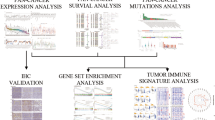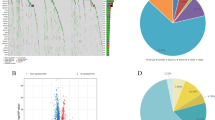Abstract
Background
PTPRF-interacting protein alpha 1 (PPFIA1) plays an important role as a regulator of cell motility and tumor cell invasion and is frequently amplified in breast cancer. The aim of this study was to investigate the clinicopathologic features, survival, anticancer immunities and specific gene sets related to high PPFIA1 expression in patients with breast cancer. We verified the importance of PPFIA1 and survival rates using machine learning and identified drugs that can effectively reduce breast cancer cells with high PPFIA1 expression.
Methods
This study analyzed clinicopathologic factors, survival rates, immune profiles and gene sets according to PPFIA1 expression in 3457 patients with breast cancer from the Kangbuk Samsung Medical Center cohort (456 cases), Molecular Taxonomy of Breast Cancer International Consortium (1904 cases) and The Cancer Genome Atlas (1097 cases). We applied gene set enrichment analysis (GSEA), in silico cytometry, pathway network analyses, in vitro drug screening, and gradient boosting machine (GBM) analysis.
Results
High PPFIA1 expression in breast cancer was associated with worse prognosis, with reduced tumor-infiltrating lymphocytes, especially CD8+ T cells, and increased PD-L1 expression. In pathway network analysis, PPFIA1 was linked directly to the tyrosine-protein phosphatase pathway and indirectly to immune pathways. The importance of PPFIA1’s association with survival in GBM analysis was higher than that of perineural and lymphovascular invasion. In in vitro drug screening, expression of PPFIA1 on mRNA level positively correlated with sensitivity of cell lines to erlotinib.
Conclusion
High PPFIA1 in patients with breast cancer is related to poor prognosis and decreased anticancer immune response, and erlotinib may be promising for development of therapeutic approaches in patients with tumors overexpressing PPFIA1.





Similar content being viewed by others
Data availability
Public data used in this work can be acquired from the portal TCGA Research Network (https://gdc.cancer.gov/about-data/publications/pancanatlas). The raw experimental data and analysis codes supporting the conclusions of this article will be made available by the corresponding author.
References
Serra-Pages C, Kedersha NL, Fazikas L, Medley Q, Debant A, Streuli M. The LAR transmembrane protein tyrosine phosphatase and a coiled-coil LAR-interacting protein co-localize at focal adhesions. EMBO J. 1995;14:2827–38. https://doi.org/10.1002/j.1460-2075.1995.tb07282.x.
Serra-Pages C, Medley QG, Tang M, Hart A, Streuli M. Liprins, a family of LAR transmembrane protein-tyrosine phosphatase-interacting proteins. J Biol Chem. 1998;273:15611–20. https://doi.org/10.1074/jbc.273.25.15611.
Shen JC, Unoki M, Ythier D, Duperray A, Varticovski L, Kumamoto K, et al. Inhibitor of growth 4 suppresses cell spreading and cell migration by interacting with a novel binding partner, liprin alpha1. Cancer Res. 2007;67:2552–8. https://doi.org/10.1158/0008-5472.CAN-06-3870.
Asperti C, Astro V, Totaro A, Paris S, de Curtis I. Liprin-alpha1 promotes cell spreading on the extracellular matrix by affecting the distribution of activated integrins. J Cell Sci. 2009;122:3225–32. https://doi.org/10.1242/jcs.054155.
Astro V, Asperti C, Cangi MG, Doglioni C, de Curtis I. Liprin-alpha1 regulates breast cancer cell invasion by affecting cell motility, invadopodia and extracellular matrix degradation. Oncogene. 2011;30:1841–9. https://doi.org/10.1038/onc.2010.562.
Astro V, Chiaretti S, Magistrati E, Fivaz M, de Curtis I. Liprin-alpha1, ERC1 and LL5 define polarized and dynamic structures that are implicated in cell migration. J Cell Sci. 2014;127:3862–76. https://doi.org/10.1242/jcs.155663.
Chiaretti S, Astro V, Chiricozzi E, de Curtis I. Effects of the scaffold proteins liprin-alpha1, beta1 and beta2 on invasion by breast cancer cells. Biol Cell. 2016;108:65–75. https://doi.org/10.1111/boc.201500063.
Dancau AM, Wuth L, Waschow M, Holst F, Krohn A, Choschzick M, et al. PPFIA1 and CCND1 are frequently coamplified in breast cancer. Genes Chromosomes Cancer. 2010;49:1–8. https://doi.org/10.1002/gcc.20713.
Al-Kuraya K, Schraml P, Torhorst J, Tapia C, Zaharieva B, Novotny H, et al. Prognostic relevance of gene amplifications and coamplifications in breast cancer. Cancer Res. 2004;64:8534–40. https://doi.org/10.1158/0008-5472.CAN-04-1945.
Siegel RL, Miller KD, Fuchs HE, Jemal A. Cancer statistics, 2021. CA Cancer J Clin. 2021;71:7–33. https://doi.org/10.3322/caac.21654.
Ji GW, Wang K, Xia YX, Wang JS, Wang XH, Li XC. Integrating machine learning and tumor immune signature to predict oncologic outcomes in resected biliary tract cancer. Ann Surg Oncol. 2021;28:4018–29. https://doi.org/10.1245/s10434-020-09374-w.
Remmele W, Stegner HE. Recommendation for uniform definition of an immunoreactive score (IRS) for immunohistochemical estrogen receptor detection (ER-ICA) in breast cancer tissue. Pathologe. 1987;8:138–40.
Wolff AC, Hammond MEH, Allison KH, Harvey BE, Mangu PB, Bartlett JMS, et al. Human epidermal growth factor receptor 2 testing in breast cancer: American Society of Clinical Oncology/College of American Pathologists Clinical Practice Guideline Focused Update. J Clin Oncol. 2018;36:2105–22. https://doi.org/10.1200/JCO.2018.77.8738.
Mok TSK, Wu YL, Kudaba I, Kowalski DM, Cho BC, Turna HZ, et al. Pembrolizumab versus chemotherapy for previously untreated, PD-L1-expressing, locally advanced or metastatic non-small-cell lung cancer (KEYNOTE-042): a randomised, open-label, controlled, phase 3 trial. Lancet. 2019;393:1819–30. https://doi.org/10.1016/S0140-6736(18)32409-7.
Pereira B, Chin SF, Rueda OM, Vollan HK, Provenzano E, Bardwell HA, et al. The somatic mutation profiles of 2433 breast cancers refines their genomic and transcriptomic landscapes. Nat Commun. 2016;7:11479. https://doi.org/10.1038/ncomms11479.
Curtis C, Shah SP, Chin SF, Turashvili G, Rueda OM, Dunning MJ, et al. The genomic and transcriptomic architecture of 2000 breast tumours reveals novel subgroups. Nature. 2012;486:346–52. https://doi.org/10.1038/nature10983.
Peng X, Chen Z, Farshidfar F, Xu X, Lorenzi PL, Wang Y, et al. Molecular characterization and clinical relevance of metabolic expression subtypes in human cancers. Cell Rep. 2018;23:255-269 e4. https://doi.org/10.1016/j.celrep.2018.03.077.
Bindea G, Galon J, Mlecnik B. CluePedia Cytoscape plugin: pathway insights using integrated experimental and in silico data. Bioinformatics. 2013;29:661–3. https://doi.org/10.1093/bioinformatics/btt019.
Bindea G, Mlecnik B, Hackl H, Charoentong P, Tosolini M, Kirilovsky A, et al. ClueGO: a cytoscape plug-in to decipher functionally grouped gene ontology and pathway annotation networks. Bioinformatics. 2009;25:1091–3. https://doi.org/10.1093/bioinformatics/btp101.
Subramanian A, Tamayo P, Mootha VK, Mukherjee S, Ebert BL, Gillette MA, et al. Gene set enrichment analysis: a knowledge-based approach for interpreting genome-wide expression profiles. Proc Natl Acad Sci USA. 2005;102:15545–50. https://doi.org/10.1073/pnas.0506580102.
Yang W, Soares J, Greninger P, Edelman EJ, Lightfoot H, Forbes S, et al. Genomics of drug sensitivity in cancer (GDSC): a resource for therapeutic biomarker discovery in cancer cells. Nucl Acids Res. 2013;41:D955–61. https://doi.org/10.1093/nar/gks1111.
Garnett MJ, Edelman EJ, Heidorn SJ, Greenman CD, Dastur A, Lau KW, et al. Systematic identification of genomic markers of drug sensitivity in cancer cells. Nature. 2012;483:570–5. https://doi.org/10.1038/nature11005.
Iorio F, Knijnenburg TA, Vis DJ, Bignell GR, Menden MP, Schubert M, et al. A landscape of pharmacogenomic interactions in cancer. Cell. 2016;166:740–54. https://doi.org/10.1016/j.cell.2016.06.017.
Choi EJ, Yun JA, Jabeen S, Jeon EK, Won HS, Ko YH, et al. Prognostic significance of TMEM16A, PPFIA1, and FADD expression in invasive ductal carcinoma of the breast. World J Surg Oncol. 2014;12:137. https://doi.org/10.1186/1477-7819-12-137.
Yang J, Wu NN, Huang DJ, Luo YC, Huang JZ, He HY, et al. PPFIA1 is upregulated in liver metastasis of breast cancer and is a potential poor prognostic indicator of metastatic relapse. Tumour Biol. 2017;39:1010428317713492. https://doi.org/10.1177/1010428317713492.
Alfarsi LH, El Ansari R, Craze ML, Masisi BK, Ellis IO, Rakha EA, et al. PPFIA1 expression associates with poor response to endocrine treatment in luminal breast cancer. BMC Cancer. 2020;20:425. https://doi.org/10.1186/s12885-020-06939-6.
Loi S, Sirtaine N, Piette F, Salgado R, Viale G, Van Eenoo F, et al. Prognostic and predictive value of tumor-infiltrating lymphocytes in a phase III randomized adjuvant breast cancer trial in node-positive breast cancer comparing the addition of docetaxel to doxorubicin with doxorubicin-based chemotherapy: BIG 02–98. J Clin Oncol. 2013;31:860–7. https://doi.org/10.1200/JCO.2011.41.0902.
Denkert C, Loibl S, Noske A, Roller M, Muller BM, Komor M, et al. Tumor-associated lymphocytes as an independent predictor of response to neoadjuvant chemotherapy in breast cancer. J Clin Oncol. 2010;28:105–13. https://doi.org/10.1200/JCO.2009.23.7370.
Mahmoud SM, Paish EC, Powe DG, Macmillan RD, Grainge MJ, Lee AH, et al. Tumor-infiltrating CD8+ lymphocytes predict clinical outcome in breast cancer. J Clin Oncol. 2011;29:1949–55. https://doi.org/10.1200/JCO.2010.30.5037.
Wang C, Zhu H, Zhou Y, Mao F, Lin Y, Pan B, et al. Prognostic value of PD-L1 in breast cancer: a meta-analysis. Breast J. 2017;23:436–43. https://doi.org/10.1111/tbj.12753.
Kim HM, Lee J, Koo JS. Clinicopathological and prognostic significance of programmed death ligand-1 expression in breast cancer: a meta-analysis. BMC Cancer. 2017;17:690. https://doi.org/10.1186/s12885-017-3670-1.
Hashimoto N, Zhang WR, Goldstein BJ. Insulin receptor and epidermal growth factor receptor dephosphorylation by three major rat liver protein-tyrosine phosphatases expressed in a recombinant bacterial system. Biochem J. 1992;284(Pt 2):569–76. https://doi.org/10.1042/bj2840569.
Muller T, Choidas A, Reichmann E, Ullrich A. Phosphorylation and free pool of beta-catenin are regulated by tyrosine kinases and tyrosine phosphatases during epithelial cell migration. J Biol Chem. 1999;274:10173–83. https://doi.org/10.1074/jbc.274.15.10173.
Soulieres D, Hirsch FR, Shepherd FA, Bordogna W, Delmar P, Shames DS, et al. PTPRF expression as a potential prognostic/predictive marker for treatment with erlotinib in non-small-cell lung cancer. J Thorac Oncol. 2015;10:1364–9. https://doi.org/10.1097/JTO.0000000000000624.
Stirnweiss A, Hartig R, Gieseler S, Lindquist JA, Reichardt P, Philipsen L, et al. T cell activation results in conformational changes in the Src family kinase Lck to induce its activation. Sci Signal. 2013;6:ra13. https://doi.org/10.1126/scisignal.2003607.
Esensten JH, Helou YA, Chopra G, Weiss A, Bluestone JA. CD28 costimulation: from mechanism to therapy. Immunity. 2016;44:973–88. https://doi.org/10.1016/j.immuni.2016.04.020.
Bommhardt U, Schraven B, Simeoni L. Beyond TCR signaling: emerging functions of Lck in cancer and immunotherapy. Int J Mol Sci. 2019;20:3500. https://doi.org/10.3390/ijms20143500.
Chakraborty G, Rangaswami H, Jain S, Kundu GC. Hypoxia regulates cross-talk between Syk and Lck leading to breast cancer progression and angiogenesis. J Biol Chem. 2006;281:11322–31. https://doi.org/10.1074/jbc.M512546200.
Sugihara T, Werneburg NW, Hernandez MC, Yang L, Kabashima A, Hirsova P, et al. YAP tyrosine phosphorylation and nuclear localization in cholangiocarcinoma cells are regulated by LCK and independent of LATS activity. Mol Cancer Res. 2018;16:1556–67. https://doi.org/10.1158/1541-7786.MCR-18-0158.
Saygin C, Wiechert A, Rao VS, Alluri R, Connor E, Thiagarajan PS, et al. CD55 regulates self-renewal and cisplatin resistance in endometrioid tumors. J Exp Med. 2017;214:2715–32. https://doi.org/10.1084/jem.20170438.
Zepecki JP, Snyder KM, Moreno MM, Fajardo E, Fiser A, Ness J, et al. Regulation of human glioma cell migration, tumor growth, and stemness gene expression using a Lck targeted inhibitor. Oncogene. 2019;38:1734–50. https://doi.org/10.1038/s41388-018-0546-z.
Funding
None.
Author information
Authors and Affiliations
Contributions
JC, K-WM, and D-HK conceived of the study and were responsible for the data curation, formal analysis, investigation, methodology, resources, software, validation, visualization, and writing—original draft. K-WM and D-HK conceived of the study, acquired funding, administered the project, supervised the study, and wrote and reviewed and edited the manuscript. JC, K-WM, and D-HK wrote, reviewed and edited the manuscript. S-ID, BKS, YHO, WYJ, HSK, USJ, and MJK verified the underlying data. All authors read and approved the final version of the manuscript.
Corresponding authors
Ethics declarations
Conflict of interest
The authors declare that they have no conflict of interest.
Ethical approval
All procedures performed in studies involving human participants were in accordance with the ethical standards of the institutional and/or national research committee and with the 1964 Helsinki declaration and its later amendments or comparable ethical standards. This study was approved by the Institutional Review Board of Kangbuk Samsung Medical Center (IRB No. 2020-09-015, Seoul, Korea).
Informed consent
Informed consent was not obtained from all individual participants included in the study. IRB approved a request to waive the documentation of informed consent.
Additional information
Publisher's Note
Springer Nature remains neutral with regard to jurisdictional claims in published maps and institutional affiliations.
Supplementary Information
Below is the link to the electronic supplementary material.
About this article
Cite this article
Chu, J., Min, KW., Kim, DH. et al. High PPFIA1 expression promotes cancer survival by suppressing CD8+ T cells in breast cancer: drug discovery and machine learning approach. Breast Cancer 30, 259–270 (2023). https://doi.org/10.1007/s12282-022-01419-0
Received:
Accepted:
Published:
Issue Date:
DOI: https://doi.org/10.1007/s12282-022-01419-0




